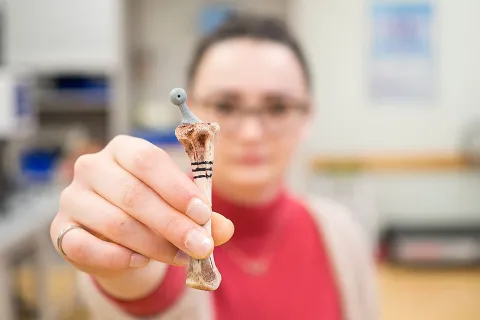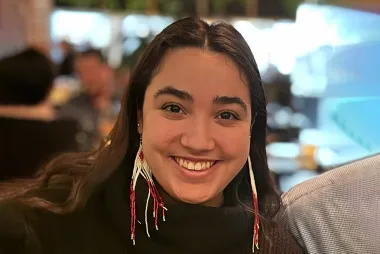
When you think electrical and computer engineering do you think hip transplants? No, probably not. How about French cooking? No? Well then, welcome to ELEC 371: Biomedical Engineering Instrumentation. A course, which is ambiguously defined in the syllabus as “theory and experiments involving instruments for general, orthopedic, cardiac and minimally invasive surgery as well as sensors for respiratory, cardiac, bioelectric, biochemical and nervous system measurement.”
The course is part of the biomedical engineering option of the electrical and computer engineering program (ECE) — which features courses based in physiology, anatomy and advanced medical devices — and was developed by ECE senior instructor, Leo Stocco (BASc ’94 ELEC, PhD ’00 ELEC), as a potential segue into medical school. “If students later decide to attend med-school, and maybe become a researching practitioner, backing up a medical degree with an engineering degree is the perfect combination of skills” says Stocco. “I was given a brief course description, a budget, a lab space and free reign to construct the course as I wanted.”
When deciding how to make this course most useful, Stocco reflected on his own experiences. Under ECE professor, Tim Salcudean, his PhD specialized in robotics and control. “Of all my experiences, two things stick out as most useful. The first was a course with mechanical engineering professor, Tony Hodgson, who took us to a bunch of surgeries — it was life changing… to actually put on scrubs and be right there splattered with blood; you really got to see what being part of a medical procedure was all about. And the second was interactions with other grad students. Although he was studying pure robotics, he shared a lab with grad students who worked on medical robotics. “They always needed test subjects to see if what they were doing made an improvement” says Stocco, “and I was a test subject in suturing experiments more times than I can count. I haven’t been a student for almost 20 years now, but I still remember how to suture and I remember those trips to the operating room like they happened yesterday.”
He decided that ELEC 371 needed to be based in experiences, and not learned from a book. Thus, the course was developed with two sessions per week: a classroom lecture and a lab: the lecture introduces the project and provides background on anatomy, physiology, pathology and the devices, and the lab requires students to develop a practical, hands-on solution.
After completing his PhD, Stocco went on to lead the Robotics Group at Integrated Surgical Systems, which builds a surgical robot for total hip and knee arthroplasty surgery. “You have a bone and an implant, and you need the implant to sit firmly inside the bone” he says. “A bone has a very curvaceous figure, so the medical implant is not just a straight piece of metal. Cutting that hole is really hard, which is why we developed a robot to do it: to make that implant fit perfectly.”
For one particular lab project, the students are required to design and execute a hip transplant surgery, using chicken bones and a 3-D printer. “This is my area of expertise,” says Stocco. “Of course there was going to be a lab on this!”
Due to the complexity of this particular project, it takes up two weeks within the curriculum: one to design the implant, and a second to implant it.
And this is where we introduce the French cooking… In order to complete the project, the students need bones, and since human femoral bones aren’t so easy to come by, they use chicken legs, which is what brings that added touch of ingenuity to this project. You can’t just buy the legs from a take-out restaurant, says Stocco, you need the knee joint of the chicken intact to complete the procedure, so a whole leg and thigh is required.
He buys halal chicken (to be inclusive) and always prepares the chickens with a very specific Jacques Pépin recipe. Because in order to perform the surgery, the bones must be stripped and cleaned, and the surgeons must be well fed! “The students love it!” he says.
The second session is implantation: fixating the bone, cutting it off, drilling out a hole and making adjustments, very much like you would in an actual surgery. “Each bone is different” explains Stocco, “like with snowflakes. And each implant must be designed for the particular bone.” The students wear smocks and goggles because chicken flesh and pieces of bone are flying everywhere. But while this may sound like a lot of fun, it’s no game, insists Stocco. “The point is to appreciate how difficult this procedure really is. You see ultra-skilled surgeons doing it on TV and you think ‘sure, that looks tricky,’ but in reality it’s IMPOSSIBLY difficult.”
Through the hip transplant and the other lab projects in this course, the students gain experience of medical procedures that could not be gained through any textbook. The hands-on experience with the devices is key; the perspective they gain on the challenges of creating and using these devices is critical to improving the user experience of the medical professionals who will be using them in practice.
“I think the ‘groundedness’ of this course is something that resonates with students. This is one of their first opportunities to interact with medical devices, and it helps provide a fundamental introduction to clinical engineering” says course teaching assistant, Jeanie Malone (BASc ’17 ELEC). “Putting things like sutures, or scalpels — or chicken legs and 3D printed hip implants! — in their hands is something that sticks with students. Opportunities like these are the backbone of the biomedical option within electrical engineering.”
With the introduction of the new UBC School of Biomedical Engineering in 2018, the fate of this course is somewhat uncertain. Will it be absorbed into the biomedical engineering undergraduate curriculum? Will it hybridize into a cross-departmental course? Will it receive a total overhaul? Stocco can’t say for sure, but for now… the students are still enjoying the unlikely marriage of Jacques Pépin and the 3D printers!



